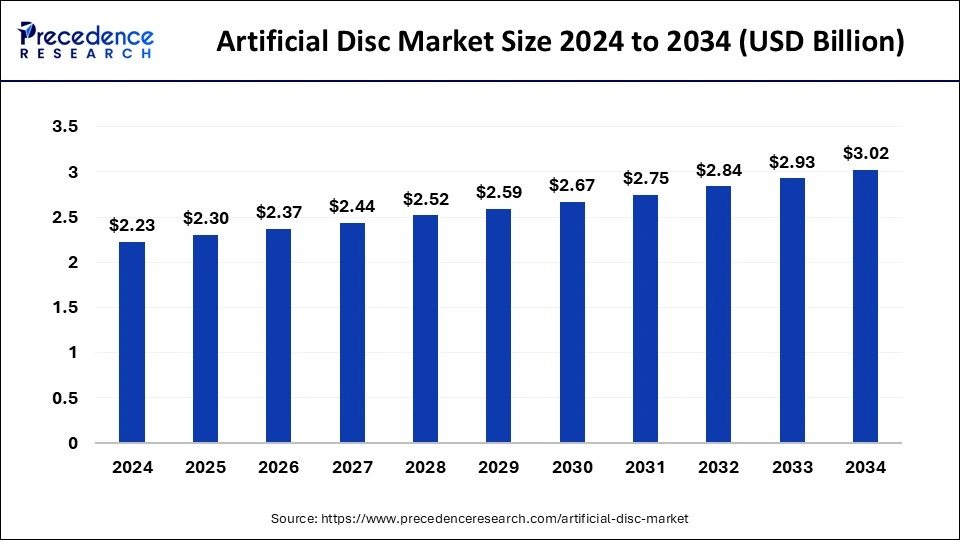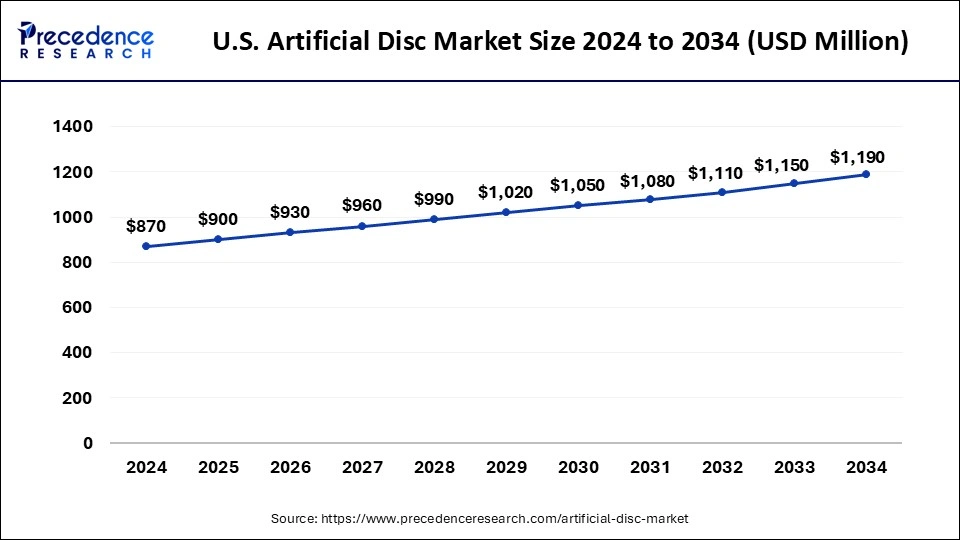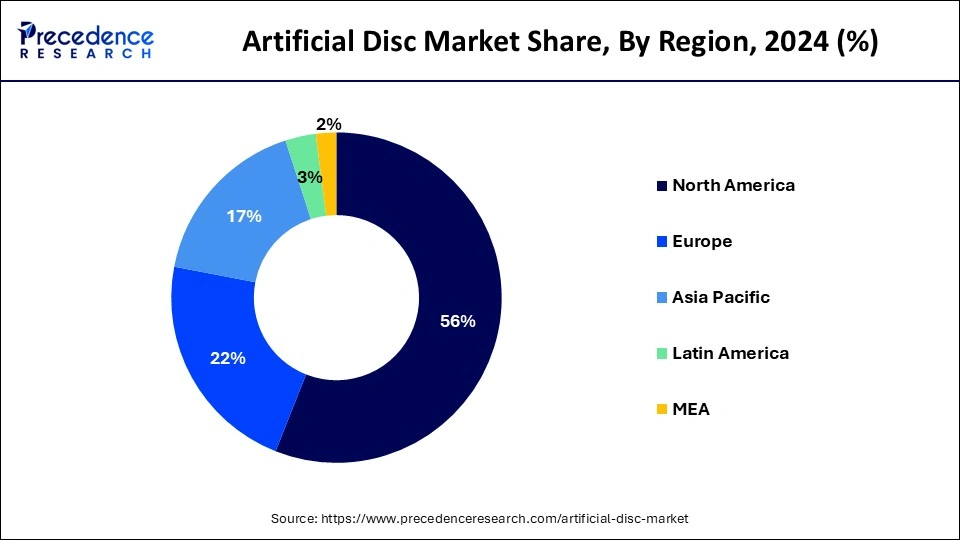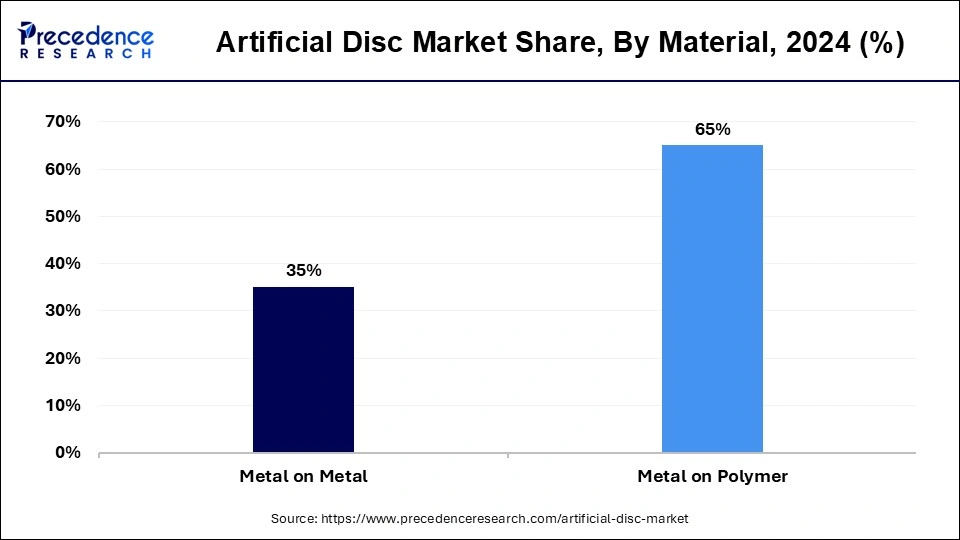August 2024
The global artificial disc market size is calculated at USD 2.30 billion in 2025 and is forecasted to reach around USD 3.02 billion by 2034, accelerating at a CAGR of 3.08% from 2025 to 2034. The North America market size surpassed USD 1.25 billion in 2024 and is expanding at a CAGR of 3.12% during the forecast period. The market sizing and forecasts are revenue-based (USD Million/Billion), with 2024 as the base year.
The global artificial disc market size was estimated at USD 2.23 billion in 2024 and is predicted to increase from USD 2.30 billion in 2025 to approximately USD 3.02 billion by 2034, expanding at a CAGR of 3.08% from 2025 to 2034. The increasing applications of artificial discs and a growing number of artificial disc replacement procedures considered viable for long-term therapeutic management support the market's growth.

The U.S. artificial disc market size was exhibited at USD 870 million in 2024 and is projected to be worth around USD 1,190 million by 2034, growing at a CAGR of 3.18%.

North America held the biggest market share of 56% in 2024, owing to the presence of key players and advanced healthcare facilities in the United States and Canada. The region leverages extensive research, robust reimbursement systems, and a substantial patient population. Notably, the United States has spearheaded the adoption of artificial disc technologies. Anticipated growth in the North American market is fueled by a surge in degenerative bone diseases, an uptick in lower back syndromes, and heightened awareness of effective spinal disc replacement procedures. Primary healthcare providers are actively enhancing accessibility to meet the rising demand for disc replacement procedures, further propelling regional growth.
A research study published in the European Spine Journal in 2022 estimated a prevalence of lower back pain (LBP) at 1,362.08 cases per 100,000 people in the North American population. The increasing number of patients seeking diagnosis and treatment for spinal disc correction, coupled with government reimbursements supporting the adoption of disc implants, is contributing to the growth of the artificial disc market in North America.

Europe is expected to witness notable growth during the forecast period. This growth is driven by the increasing patient population in the region seeking disc replacement surgeries, which is propelled by a rising number of elderly individuals more susceptible to bone disorders like scoliosis and degenerative disc diseases. This trend, coupled with well-equipped surgical centers, a range of products from key market players, and a higher disposable income among patients, is expected to drive growth in the region. The upsurge in the geriatric demographic and the associated risk of bone disorders are foreseen to contribute significantly to the increased demand for surgical procedures aimed at the long-term management of spinal issues. Furthermore, the region's higher disposable income and the adoption of innovative surgical methods for spinal disc replacement are anticipated to bolster growth further.
An artificial disc is a part of arthroplasty implanted into the cervical or lumbar spine to imitate the function of injured intervertebral discs. It comprises two endplates of materials like titanium alloy, cobalt-chromium, or medical-grade polyethylene. The flexible and compressible device enables movement and flexibility while minimizing back strain. A better understanding of degenerative disc diseases and spinal-related ailments increases the demand for the artificial disc market.
| Report Coverage | Details |
| Market Size in 2025 | USD 2.30 Billion |
| Market Size by 2034 | USD 3.02 Billion |
| Market Growth Rate from 2025 to 2034 | CAGR of 3.08% |
| Base Year | 2024 |
| Forecast Period | 2025 to 2034 |
| Segments Covered | Type, Material, Indication, and End-use |
| Regions Covered | North America, Europe, Asia-Pacific, Latin America, and Middle East & Africa |
Increasing prevalence of degenerative disc diseases
The increasing occurrence of degenerative disc diseases, like cervical and lumbar disc degeneration, is a crucial driver for the growth of the artificial disc market. Disc degeneration, often linked with aging, leads to persistent back and neck pain, affecting mobility and quality of life.
The global rise in the aging population is contributing to a higher prevalence of disc diseases, creating a significant demand for effective surgical solutions such as artificial disc replacement. Moreover, the artificial disc market is expected to grow with the increasing use of artificial discs and the number of artificial disc replacement procedures as effective long-term therapeutic solutions.
Minimally invasive spine surgery procedures
The growing acceptance of minimally invasive procedures, such as anterior cervical disc replacement with smaller incisions, is driving the adoption of artificial discs. These procedures result in less blood loss, shorter hospital stays, lower costs, and faster patient recovery than open surgeries. The appeal of these benefits is prompting many patients and surgeons to choose minimally invasive artificial disc replacement surgeries, contributing to the growth of the artificial disc market.
High cost of cervical and lumbar artificial discs
The significant expense associated with artificial intervertebral discs and costly surgical procedures is a major obstacle impacting market growth. Artificial disc surgeries can cost between US$ 50,000 and US$ 70,000, depending on the disc type and region. These high costs restrict the number of patients who can afford the procedures, mainly due to economic factors. Additionally, the need for favorable reimbursement in developing regions further hampers the prospects of the artificial disc market.
Innovation and rise in demand for spinal procedures
The artificial disc market is predominantly fueled by innovations in technologies, driven by the increasing need for spinal therapies and expanding opportunities in fields like advanced predictive procedure planning algorithms and spinal robotic surgeries. The recent uptick in cervical disc injuries and corrective surgeries will contribute to market growth. Additionally, the growing global geriatric population, often developing spinal diseases due to frailty and other health issues, is increasing the number of patients seeking spinal diagnosis and opting for disc replacement procedures.
A research study published in 2022 by Acta Neurochirurgica revealed that around 33.5% of cervical spine injuries in the U.S. were treated with surgery. This indicates a growing preference among medical practitioners for corrective surgeries over traditional conservative treatment for such conditions. This shift is anticipated to boost the adoption of artificial discs and contribute to the market's growth.
New product launches and approvals
Manufacturers have significant growth opportunities by introducing new designs and models of artificial discs. The numerous product launches and approvals in recent years underscore the substantial potential in the market. Companies invest significantly in research and development to create advanced artificial discs and secure regulatory approvals. This strategic approach helps them gain a first-mover advantage and strengthen their position in the market.
The cervical artificial disc segment held a significant share in 2024. This is primarily due to the shift in preferences for minimally- or non-invasive therapies and the adoption of cervical disc replacements in comparison to lumbar disc procedures. The higher incidence of cervical injuries and lifestyle/work-related skeletal disorders contribute to the diagnosis of these conditions and the preference for spinal management. Moreover, market players are innovating implants specifically for cervical-oriented vertebral procedures to meet the greater demand, further fostering the growth of this segment.
The lumbar artificial disc segment is anticipated to witness notable growth during the forecast period. Artificial lumbar discs have the ability to preserve spinal motion while providing stability. In the past, fusion implants were used for lumbar disc implantation, offering stability but leading to longer rehabilitation times and impacting the patient's quality of life. The introduction of lumbar discs allows for managing nerve pinching, faster healing, and preserving spinal motility. This, coupled with a preference among experts for using lumbar discs in managing chronic lower back pain among a larger patient population, is expected to boost the growth of this segment.
The metal-on-polymer segment dominated the artificial disc market share of 65% in 2024. Many FDA-approved cervical total disc replacement implants in the U.S. use a combination of metal alloy-based endplates and a central core made of medical-grade plastic. This combination of metal and plastic has demonstrated a high success rate in artificial disc replacement procedures, contributing significantly to the market's expansion.

The metal-on-metal segment is projected to witness the fastest market growth during the forecast period. This indicates a strong preference for metal-based implants compared to other materials. Metal-based implants, including those made from cobalt, stainless steel, and titanium-based alloys, are widely used in various orthopedic implants. They are favored for being durable, cost-effective, and possessing excellent mechanical properties. Ongoing developments and research to create degradable metal-based implants are expected to boost the artificial disc industry further.
The degenerative spine diseases segment held a significant market share in 2024. The increasing number of patients affected by this condition is anticipated to drive the global demand for artificial disc replacement procedures. The presence of degenerated discs in the lumbar spine raises the risk of chronic lower back pain, necessitating proper treatment. Chronic lower back pain substantially contributes to the healthcare burden, prompting several governments to introduce favorable policies.
The spinal trauma segment will experience significant growth over the forecast period. This is linked to the harm inflicted on the spinal cord, spinal column, or the bones encasing the spinal cord due to an injury. The spinal cord houses nerves responsible for transmitting messages between the brain and the body, and any damage can result in lasting alterations to bodily functions.
The ambulatory surgical centers segment has been the dominant force in the artificial disc market throughout the study period. This is attributed to many spine surgeons operating in privately held or corporately managed ambulatory surgical centers. These settings offer surgeons greater flexibility in tailoring treatments for patients, shorter procedure times, and cost-effectiveness. Additionally, orthopedic surgeons can provide super-specialized treatments in these centers, surpassing the capabilities of more extensive hospital settings.
The hospital segment is expected to experience substantial growth in the artificial disc market, primarily due to the traditional preference of patients choosing treatment within the institutional system. Additionally, the increasing adoption of artificial disc procedures, more extensive medical infrastructure to meet growing surgical demands, and an efficient workflow to handle higher patient volumes contribute to the growth of the hospital segment in the market.
By Type
By Material
By Indication
By End-use
By Geography
For inquiries regarding discounts, bulk purchases, or customization requests, please contact us at sales@precedenceresearch.com
No cookie-cutter, only authentic analysis – take the 1st step to become a Precedence Research client
August 2024
December 2024
September 2024
April 2025